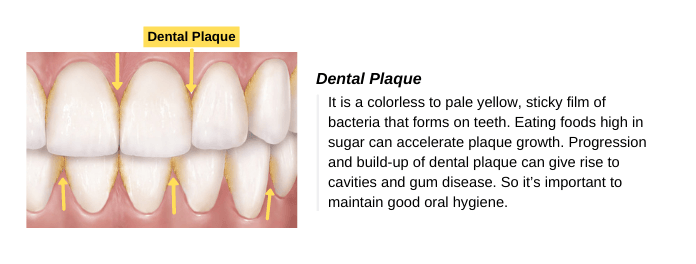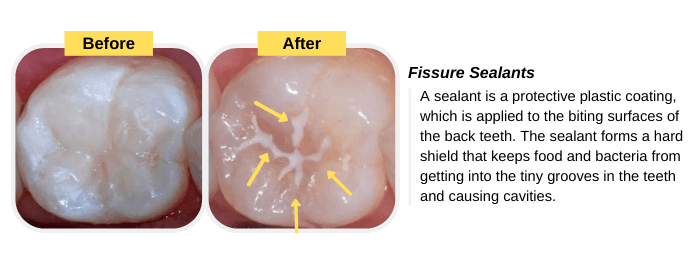Teeth have an important role in toddlers’ overall health and development. The anterior teeth cut food into pieces, and posterior teeth grind the food, which facilitates swallowing and digestion. Also, they help your toddler develop their speech. Cavities in toddlers cause pain and discomfort, which makes it difficult for a toddler to sleep, play, eat, and talk, impacting their overall health and development.
The risk of cavities in toddlers starts with the eruption of the first primary teeth at the age of 6 months. If you don’t clean your toddler’s teeth well, dental plaque will accumulate on teeth surfaces. Plaque is a sticky, colorless film of bacteria that decompose carbohydrates (sugars and starches), producing acids as a result. Over time, these acids break down the tooth enamel, resulting in cavities.
Symptoms of Cavities in Toddlers
In the early stage of dental caries, white lines or spots appear on the primary teeth surfaces due to the loss of tooth minerals (demineralization). In this stage, dental caries can be reversed by fluoride (remineralization) if the tooth enamel is still intact. As caries advances, cavities begin to form. They are permanent damage to the tooth, which appear as holes or tiny openings. Over time, these holes may extend to deeper layers, causing pain and dental abscess. The signs and symptoms of cavities in toddlers include:
- White lines or spots on primary teeth surfaces in the early stage of dental caries.
- Brown or black holes that gradually become bigger (advanced stage).
- Increased sensitivity to sweet, hot, or cold.
- Pain with biting or chewing.
- Continuous pain.
- Food particles get trapped between primary teeth.
- Gum swelling and pus discharge.
- Persistent bad breath.
- Swelling of the face.

Causes of Cavities in Toddlers
Primary teeth, also known as deciduous teeth, baby teeth, or milk teeth, are the first set of teeth that your toddler develops. Usually, they begin to erupt at the age of 6 months and continue until 25 – 33 months of age. The risk of cavities in toddlers begins with the eruption of the first primary tooth. Certain bacteria in the mouth feed on carbohydrates in food such as sucrose, fructose, and glucose. Then, these bacteria produce acid that breaks down the tooth enamel and causes cavities in toddlers.
Risk Factors
- Not cleaning your toddler’s teeth well: dental plaque is a mass of bacteria that forms on teeth every day. These bacteria convert carbohydrates into acid, which breaks down the tooth enamel.
- Consumption of foods high in sugar: for example, cake, cookies, biscuits, soda, and fruit juice. These foods and drinks provide a sugar-rich environment for bacteria and increase the risk of cavities in toddlers.
- Foods that cling to toddler’s teeth for a long time: such as milk, ice cream, dried fruits, dry cereal, and chips.
- Tooth location: cavities occur most often in posterior teeth because they have a lot of grooves that collect food particles. Anterior teeth are easier to keep clean than the posterior teeth because they have smooth surfaces.

Complications of Cavities in Toddlers
Cavities in toddlers can cause serious and lasting complications, include:
- Pain that worsens over time.
- Gum swelling and pus discharge.
- Tooth fracture and even tooth loss.
- Nutrition problems due to painful or difficult chewing.
- Weight loss as a result of impaired toddler’s nutrition.
- Pain that interferes with daily living.
- The early loss of primary teeth can lead to permanent teeth shifting because primary teeth preserve the position of permanent teeth.
Diagnosis of Cavities in Toddlers
Cavities in toddlers can be found during a regular dental check-up. Early dental caries appears as white lines or spots on teeth. When caries progresses, cavities begin to form. They may appear as brown or black holes. The dentist will check your toddler’s mouth by:
- Mirror and probe: the dentist will use a mirror and probe to examine your toddler’s mouth and spot caries areas.
- X-ray: the dentist may take an x-ray to check for interproximal cavities and dental abscess.
Treatment of Cavities in Toddlers
The treatment of cavities in baby teeth vary, depending on the size of the damage and the condition of the tooth. The treatment includes:
- Tooth restoration: your toddler’s dentist will clean the caries areas under local anesthesia. Then, they will place a tooth filling to restore the function and shape of the tooth. Types of tooth restorations include amalgam, composite, and glass ionomer.
- Pulpotomy or pulpectomy: bacteria may reach the tooth pulp, causing continuous pain. So, your toddler’s dentist may recommend the removal of pulp tissues partially (pulpotomy) or completely (pulpectomy).
- Stainless steel crowns: after pulpotomy or pulpectomy, your child may need a stainless steel crown to protect the tooth and restore the function.
- Tooth removal: if your child’s tooth is severely damaged, the dentist may recommend the removal of the damaged tooth. Also, your child will need a space maintainer after the removal of the damaged tooth to preserve the space allow the permanent teeth to erupt into the correct alignment.
Prevention of Cavities in Toddlers
Treating cavities in toddlers is important, but prevention is the best. So, you should:
- Maintain good oral hygiene: brush your toddler’s teeth regularly with a small, soft-bristled toothbrush. Don’t use toothpaste.
- Limit sugary foods and drinks: encourage your toddler to eat healthy foods such as fruits instead of foods high in sugars and refined carbs. Besides, make your toddler drink water after sugary snacks or drinks.
- Fissure sealants: food particles get stuck in the groves of the posterior teeth for a long time, which increases the risk of cavities in toddlers. So, consider placing fissure sealants (protective plastic coating) on the chewing surfaces of your toddler’s posterior teeth to prevent food and bacteria from getting into these groves.
- Regular visits to the dentist: visit your toddler’s dentist regularly for a check-up and professional cleaning. The dentist can spot cavities early and treat them before the occurrence of any complications.

Summary
- Cavities can impact your toddlers’ overall health and development.
- Because they cause pain and discomfort, which makes it difficult for a toddler to sleep, play, eat, and talk.
- Certain bacteria in the mouth decompose carbohydrates (sugars and starches), producing acids as a result.
- Bacterial acids break down the tooth enamel, forming brown or black holes. These holes are known as cavities.
- Risk factors include poor oral hygiene, consumption of sugary foods and drinks, and tooth location. Posterior teeth have a higher risk of cavities than smoother anterior teeth.
- Untreated cavities can lead to complications such as severe pain, gum swelling, facial swelling, and tooth loss.
- The treatment includes tooth restoration, pulpotomy or pulpectomy, and tooth removal.
- It is better to prevent cavities in toddlers from happening than it is to deal with it after it has happened. So, brush your toddler’s teeth regularly with a small, soft-bristled toothbrush, and visit the dentist for a regular check-up.